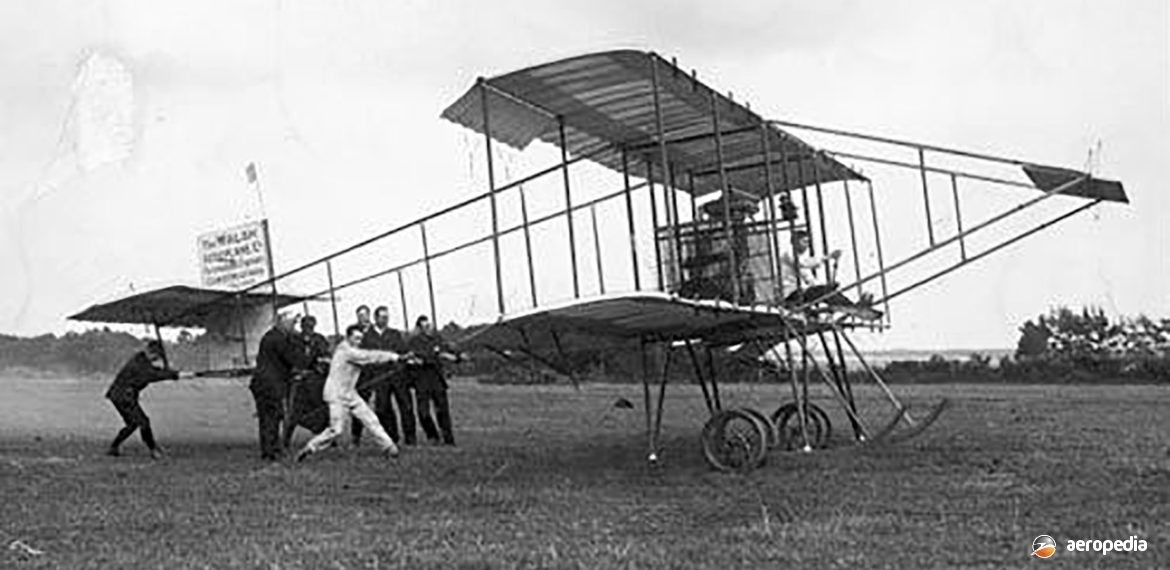Photograph:
Howard Wright Biplane ‘Manurewa’ in about 1910 (Unknown)
Country of origin:
New Zealand
Description:
One or two-seat biplane
Power Plant:
One 40 kw (60 hp) ENV eight-cylinder liquid-cooled engine
Specifications:
- Wingspan: 10.97 m (36 ft)
- Wingspan with extensions: 14.63 m (48 ft)
- Length: 11.12 m (36 ft 6 in)
- Speed range: 58 to 72 km/h (36 to 45 mph)
- Weight: 363 kg (800 lb)
History:
Leo Austin Walsh was born in Bradford, Yorkshire, in 1881, his family emigrating to Auckland in 1883. His brother, Vivian Claude Walsh, was born in New Zealand in 1888. They were educated at King’s College, Auckland. Leo became an engineer and was an importer of diesel engines. Both brothers were interested in mechanics and engineering and, following encouragement by their father, in 1910 they decided to build an aeroplane of their own design and attempt to fly it. A syndicate was formed, with the assistance of local businessmen, to support an aeroplane building venture and, to assist in construction, parts were imported to enable construction of an aircraft.
This machine was marketed by Howard Wright [no relation to the American Wright brothers] and has been described as a variant of the Farman Biplane produced in France by Henry Farman. Farman was one of the first customers for a Voisin in about 1907. He made a number of alterations to the design, and it became known as the Farman I. Further developments were the models II and III. Howard T Wright obtained a Farman and adapted it for his own use, going on to produce further examples, and later designs. Two other examples with the ENV engine were built, one for Sir Thomas Sopwith and the other for Mr W C England of Rangoon.
The Walsh brothers imported a Howard Wright biplane, which was supplied in the form of parts and plans. It cost the sum of £765 ($1,530) and consisted of rolls of wire and cloth, an engine, and roughly cut spars and straight sections, drawings being supplied. Engine was a 40 kw (60 hp) ENV eight-cylinder liquid-cooled unit. By late 1910 the airframe was completed, was transported to a field at Glenora Park, Papakura, NZ, and was placed under a large marquee, where Leo and Vivian, assisted by their sisters Veronica and Doreen, commenced the preparation and sewing by hand of the wing coverings from 50 m² (538 sq ft) of fabric. Painted on the tail was the inscription ‘The Walsh Aeroplane Company, Aeronautical Engineers, Constructors, Auckland, Registered No 1′, with a family crest below encircling the words ‘Aero Club New Zealand’.
The construction of this aircraft, named ‘Manurewa I’ (Maori for floating or soaring bird) was completed and newspapermen and photographers attended the scene for the first flight, Sir Joseph Ward being asked to name the machine. Test flights were made at Papakura on 5 February 1911. Initial tests were without ailerons but, as the aircraft bounced into the air several times as it taxied at speed around the field, adjustments had to be made to the undercarriage and rigging wires; and ailerons were installed in order for the machine to fly.
Vivian Walsh was chosen to be the pilot, but he had had no instruction and it was necessary for him to teach himself whilst testing the machine. Reports indicated the aircraft achieved a height of 18 m (60 ft) and covered a distance of 365 m (119 ft). This was generally considered to be the first successful flight of an aeroplane in New Zealand.
Successive flights continued until a month later when Vivian took off on the third flight and the undercarriage caught on a mound in the ground, splintering the undercarriage skid. The plane overturned, crashed and was wrecked. Vivian Walsh escaped relatively unscathed.
The syndicate wanted the aircraft to make exhibition flights for the public so they could recoup some of their outlay. Vivian Walsh believed he did not have enough experience for such events. Despite the damage sustained, the machine was rebuilt and made further flights. The syndicate backing the aircraft was interested in having the machine taken to Auckland for demonstration flights in April 1911 but the brothers Walsh were not interested and the machine was taken out of the hands of the builders.
Two years later ‘Manurewa I’, following the rebuild, was in the hands of the syndicate. The latter obtained the services of Australian aviator, Frederick E Sandford, as pilot, and Billy Miller as engineer. They extensively modified the machine, these modifications including the sweeping back of the outer wing panels and installing of a semi-enclosed cockpit. It was flown, this time at Avondale Racecourse, in February 1913. Sandford managed a flight with a M/s Lester as passenger, which ended in a forced landing in a New Lynn resident’s back yard. Sandford attempted to fly the aircraft from Avondale Park in Auckland to Alexandra Park, a distance of some 10 km (6.2 miles) but the wings were said to be “waterlogged” and the attempt ended at the boundary fence. Sandford was seriously injured. The machine was written off and not rebuilt.

